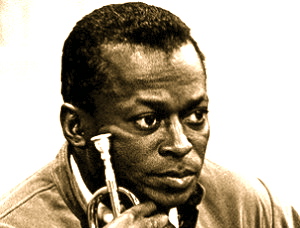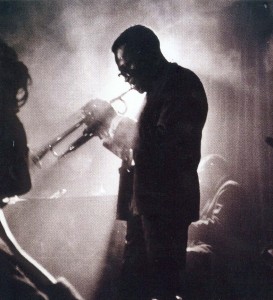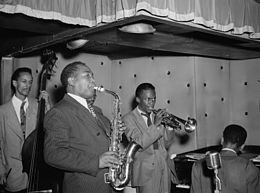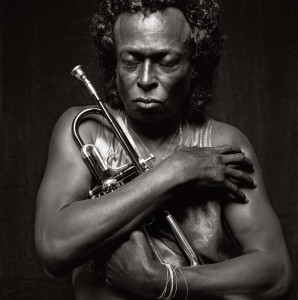Miles Davis

Miles Davis: “So What”
(born May 26, 1926 – died September 28, 1991) was an American jazz musician, trumpeter, bandleader, and composer. Widely considered one of the most influential musicians of the 20th century, Miles Davis was, with his musical groups, at the forefront of several major developments in jazz music, including bebop, cool jazz, hard bop,modal jazz, and jazz fusion.
Early life (1926–44)
 Miles Dewey Davis was born on May 26, 1926, to an affluent African American family inAlton, Illinois. His father, Dr. Miles Henry Davis, was a dentist. In 1927 the family moved to East St. Louis, Illinois. They also owned a substantial ranch in northern Arkansas, where Davis learned to ride horses as a boy.
Miles Dewey Davis was born on May 26, 1926, to an affluent African American family inAlton, Illinois. His father, Dr. Miles Henry Davis, was a dentist. In 1927 the family moved to East St. Louis, Illinois. They also owned a substantial ranch in northern Arkansas, where Davis learned to ride horses as a boy.
Davis’ mother, Cleota Mae (Henry) Davis, wanted her son to learn the piano; she was a capable blues pianist but kept this fact hidden from her son. His musical studies began at 13, when his father gave him a trumpet and arranged lessons with local musician Elwood Buchanan. Davis later suggested that his father’s instrument choice was made largely to irk his wife, who disliked the trumpet’s sound. Against the fashion of the time, Buchanan stressed the importance of playing without vibrato; he was reported to have slapped Davis’ knuckles every time he started using heavy vibrato. Davis would carry his clear signature tone throughout his career. He once remarked on its importance to him, saying, “I prefer a round sound with no attitude in it, like a round voice with not too much tremolo and not too much bass. Just right in the middle. If I can’t get that sound I can’t play anything.” Clark Terry was another important early influence.
 By age 16, Davis was a member of the music society and playing professionally when not at school. At 17, he spent a year playing in Eddie Randle’s band, the Blue Devils. During this time, Sonny Stitt tried to persuade him to join the Tiny Bradshaw band, then passing through town, but Davis’ mother insisted that he finish his final year of high school. He graduated from East St. Louis Lincoln High School in 1944.
By age 16, Davis was a member of the music society and playing professionally when not at school. At 17, he spent a year playing in Eddie Randle’s band, the Blue Devils. During this time, Sonny Stitt tried to persuade him to join the Tiny Bradshaw band, then passing through town, but Davis’ mother insisted that he finish his final year of high school. He graduated from East St. Louis Lincoln High School in 1944.
In 1944, the Billy Eckstine band visited East St. Louis. Dizzy Gillespie and Charlie Parker were members of the band, and Davis was brought in on third trumpet for a couple of weeks because the regular player, Buddy Anderson, was out sick. Even after this experience, once Eckstine’s band left town, Davis’ parents were still keen for him to continue formal academic studies.
New York and the bebop years begin (1944–48)
 Charlie Parker, Tommy Potter, Miles Davis, Duke Jordan, Max Roach, August 1947
Charlie Parker, Tommy Potter, Miles Davis, Duke Jordan, Max Roach, August 1947
In the fall of 1944, following graduation from high school, Davis moved to New York City to study at the Juilliard School of Music.
Upon arriving in New York, he spent most of his first weeks in town trying to get in contact with Charlie Parker, despite being advised against doing so by several people he met during his quest, including saxophonist Coleman Hawkins.
Finally locating his idol, Davis became one of the cadre of musicians who held nightlyjam sessions at two of Harlem‘s nightclubs, Minton’s Playhouse and Monroe’s. The group included many of the future leaders of the bebop revolution: young players such as Fats Navarro, Freddie Webster, and J. J. Johnson. Established musicians including Thelonious Monk and Kenny Clarke were also regular participants.
 Davis dropped out of Juilliard, after asking permission from his father. In his autobiography, Davis criticized the Juilliard classes for centering too much on the classical European and “white” repertoire. However, he also acknowledged that, while greatly improving his trumpet playing technique, Juilliard helped give him a grounding in music theory that would prove valuable in later years.
Davis dropped out of Juilliard, after asking permission from his father. In his autobiography, Davis criticized the Juilliard classes for centering too much on the classical European and “white” repertoire. However, he also acknowledged that, while greatly improving his trumpet playing technique, Juilliard helped give him a grounding in music theory that would prove valuable in later years.
Davis began playing professionally, performing in several 52nd Street clubs with Coleman Hawkins and Eddie “Lockjaw” Davis. In 1945, he entered a recording studio for the first time, as a member of Herbie Fields‘s group. This was the first of many recordings to which Davis contributed in this period, mostly as a sideman. He finally got the chance to record as a leader in 1946, with an occasional group called the Miles Davis Sextet plus Earl Coleman and Ann Hathaway—one of the rare occasions when Davis, by then a member of the groundbreaking Charlie Parker Quintet, can be heard accompanying singers. In these early years, recording sessions where Davis was the leader were the exception rather than the rule; his next date as leader would not come until 1947.
Around 1945, Dizzy Gillespie parted ways with Parker, and Davis was hired as Gillespie’s replacement in his quintet, which also featured Max Roach on drums, Al Haig (replaced later by Sir Charles Thompson and Duke Jordan) on piano, and Curley Russell (later replaced byTommy Potter and Leonard Gaskin) on bass.


